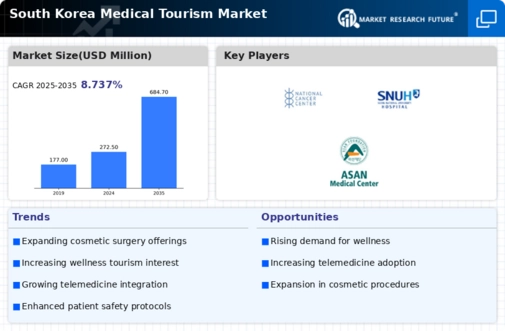Innovative Treatment Options
The medical tourism market in South Korea is characterized by its innovative treatment options, particularly in fields such as cosmetic surgery, orthopedics, and cancer treatment. The country is at the forefront of medical research and development, offering cutting-edge therapies that are not widely available elsewhere. For example, South Korea has pioneered techniques in minimally invasive surgery and regenerative medicine, attracting patients seeking the latest advancements in healthcare. This focus on innovation not only enhances the appeal of the medical tourism market but also positions South Korea as a leader in medical technology, potentially increasing its share of international patients seeking specialized care.
Cultural Appeal and Hospitality
Cultural factors significantly influence the medical tourism market in South Korea. The country's rich history, unique traditions, and renowned hospitality create an inviting atmosphere for international patients. Many visitors are drawn not only for medical treatments but also for the opportunity to experience South Korean culture. The integration of wellness tourism, including traditional therapies and spa treatments, complements medical services, enhancing the overall experience for patients. This cultural appeal, combined with the high standards of care, positions South Korea favorably in the medical tourism market, as patients often seek a holistic approach to their health and well-being.
Cost-Effective Treatment Options
Cost considerations play a crucial role in the medical tourism market, particularly in South Korea. The country offers a range of medical services at competitive prices compared to Western nations. For instance, procedures such as cosmetic surgery and dental care can be up to 50% cheaper than in the US or Europe. This affordability, combined with high-quality care, attracts a diverse clientele seeking value for their healthcare expenditures. The medical tourism market in South Korea is thus bolstered by the perception of receiving premium services without the exorbitant costs typically associated with such treatments in other regions. This financial incentive is likely to continue driving growth in the sector.
Government Initiatives and Support
Government initiatives play a pivotal role in shaping the medical tourism market in South Korea. The South Korean government actively promotes the country as a premier destination for medical tourism through various campaigns and incentives. Recent policies have focused on improving infrastructure, streamlining visa processes, and enhancing the overall patient experience. These efforts are reflected in the increasing number of international patients, with a reported % growth in arrivals over the past few years. Such governmental support not only facilitates access to healthcare but also fosters a favorable environment for the medical tourism market, encouraging further investment and development in the sector.
Rising Healthcare Quality Standards
The medical tourism market in South Korea is experiencing a notable increase in healthcare quality standards. The country is recognized for its advanced medical facilities and highly trained professionals, which attract international patients seeking specialized treatments. According to recent data, South Korea ranks among the top 10 countries for healthcare quality, with a significant % of hospitals accredited by international organizations. This emphasis on quality not only enhances patient trust but also positions South Korea as a competitive destination in the medical tourism market. The integration of cutting-edge technology and adherence to strict health regulations further bolster the reputation of South Korean healthcare, making it an appealing choice for those seeking medical procedures abroad.














Leave a Comment